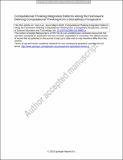Computational Thinking Integration Patterns Along the Framework Defining Computational Thinking from a Disciplinary Perspective
Author(s)
Lee, Irene; Malyn-Smith, Joyce
Download10956_2019_9802_ReferencePDF.pdf (910.9Kb)
Publisher Policy
Publisher Policy
Article is made available in accordance with the publisher's policy and may be subject to US copyright law. Please refer to the publisher's site for terms of use.
Terms of use
Metadata
Show full item recordAbstract
Abstract
This paper describes analyses of the K–12 computational thinking (CT) integration activities collected at two NSF-funded workshops, “Developing an Interdisciplinary Framework for Integrating Computational Thinking in K–12 Science, Mathematics, Technology, and Engineering Education,” held in August and November of 2017 at Education Development Center, Inc., in Waltham, Massachusetts. The workshops convened a working group of principal investigators, researchers, and educators from the National Science Foundation (NSF) ITEST (Innovative Technology Experiences for Students and Teachers) and STEM + C (STEM + Computing) funded projects to draft an interdisciplinary framework for integrating CT into K–12 education. The goal of this paper is to share that framework and our findings on promising learning progressions, gaps that exist in the collected set of activities, specific advances in STEM fields that were made possible through CT, and suggested ways that CT integration in K-12 can evolve to reach what the CT integration framework proposes as five “computational thinking integration elements” or “CTIEs”. This framework is designed to help educators see ways to engage students in CT within disciplinary learning. The analyses and findings may benefit STEM and computing education fields by elucidating the target of CT as used within CT-integrated STEM fields.
Date issued
2019-11-22Department
Massachusetts Institute of Technology. Program in Comparative Media Studies/WritingPublisher
Springer Netherlands